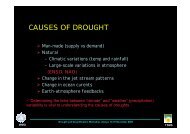Slayt 1 - RTC, Regional Training Centre - Turkey
Slayt 1 - RTC, Regional Training Centre - Turkey
Slayt 1 - RTC, Regional Training Centre - Turkey
Create successful ePaper yourself
Turn your PDF publications into a flip-book with our unique Google optimized e-Paper software.
1- NWP EquationsIn NWP, future values of meteorological variables are solved for by finding their initial values and thenadding the physical forcing that acts on the variables over the time period of the forecast. This is statedaswhere F(A) stands for the combination of all of the kinds of forcing that can occur.This stepwise process represents the configuration of the prediction equations used in NWP. Thespecific forecast equations used in NWP models are called the primitive equations (not because theyare crude or simplistic, but because they describe the fundamental processes that occur in theatmosphere). These equations govern the motion and thermodynamic changes that occur in theatmosphere and are derived from the complete conservation laws of momentum, mass, energy, andmoisture.The way in which primitive equations are derived from their complete theoretical form and convertedto computer codes can contribute to forecast errors in NWP models.1. The model forecast equations are simplified versions of the actual physical laws governing atmosphericprocesses, especially cloud processes, land-atmosphere exchanges, and radiation. The physical anddynamic approximations in these equations limit the phenomena that can be predicted.2. Due to their complexity, the primitive equations must be solved numerically using algebraicapproximations, rather than calculating complete analytic solutions. These numerical approximationsintroduce error even when the forecast equations completely describe the phenomenon of interest andeven if the initial state were perfectly represented.3. Computer translations of the model forecast equations cannot contain all details at all resolutions.Therefore, some information about atmospheric fields will be missing or misrepresented in the modeleven if perfect observations were available and the initial state of the atmosphere were known exactly.4. Grid point and spectral methods are techniques for representing information about atmosphericvariables in the model and solving the set of forecast equations. Each technique introduces differenttypes of errors.The ways in which NWP models produce forecast guidance and introduce forecast errors are exploredfurther throughout the rest of the Model Type section.
















